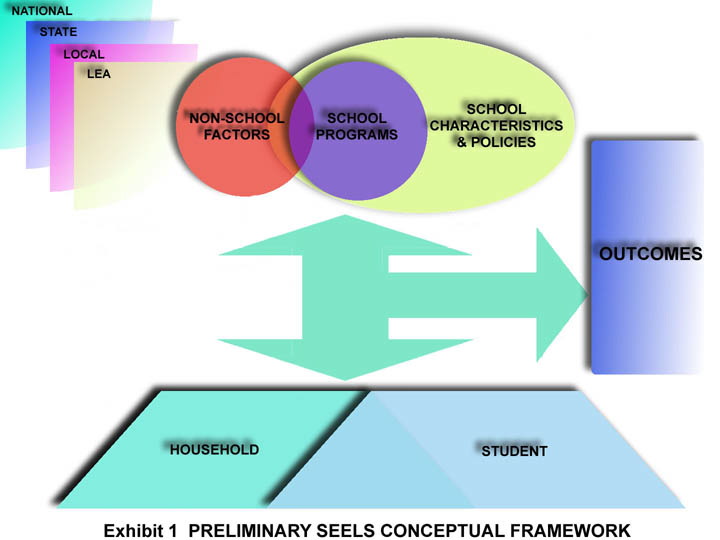
Organizing What We Want to Know: The SEELS Conceptual Framework
As mentioned earlier, the task force is asked to identify research questions that will be the focus of the study and to help develop a conceptual framework that encompasses those questions. To support these activities, we have developed a preliminary conceptual framework (Exhibit 1) that can serve as a starting point in organizing the group’s discussion of what we want to learn from SEELS. The framework identifies several domains within which various audiences may have specific issues, questions, or information needs.
The framework demonstrates the prominence of student outcomes as a focus of study. It suggests that outcomes are influenced by a multitude of factors, including the student’s school program and the school characteristics and policies that help determine that program. Because a child is much more than a student, the framework also gives prominent place to the influence of non-school factors (e.g., extracurricular activities, services) on student outcomes. The framework further suggests that both student outcomes and school and non-school factors are influenced by characteristics of the student and his or her household; i.e., what students get and how they do is in part a function of who they are and the households from which they come. These are the primary components of the framework–those that characterize the direct experience of students.
The framework also illustrates the fact that the individual experiences of children occur in the context of the district, community, state, and country in which they live. These are secondary aspects of the framework in that they less directly influence individual student experiences and outcomes. Many of these contextual factors will not be measured directly in the study, but will help in interpreting SEELS findings.
To structure our discussion of research questions, we will address each of the primary components of the framework in turn. In the following pages, we provide background on these components, working backward from an initial focus on student outcomes. In our discussion, we must weigh the following points:

Information Source. Information from a single SEELS research domain could potentially be collected from a range of sources. What sources of information are most credible for particular questions? What level of credibility is acceptable, weighing cost and logistical factors?
Each of the components of the framework is discussed below.